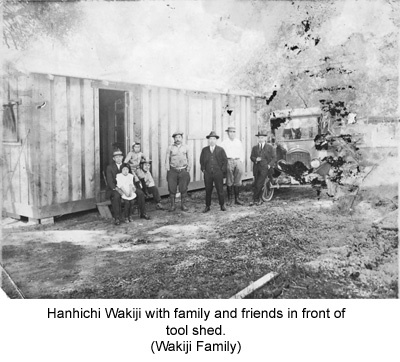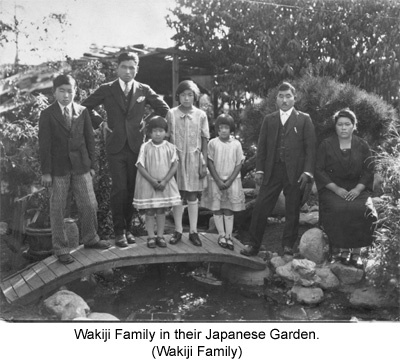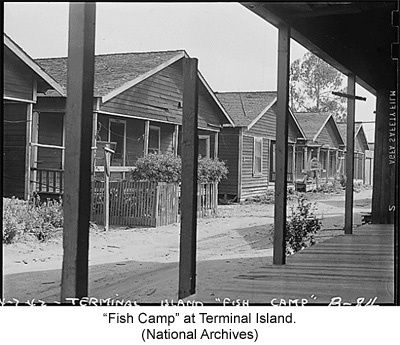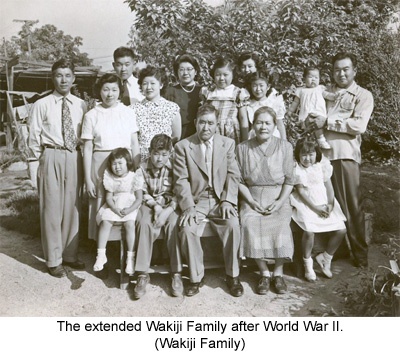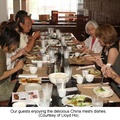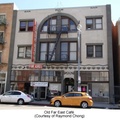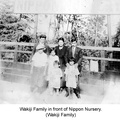Part 1 >>
Together, Hanhichi and Taeno raised six children, the Nisei generation (second generation). They were: Masa (born October 26, 1912), James Hajime (born July 11, 1914), Kaoru (born July 31, 1916), Takeko (born July 20, 1919), Mari (born March 22, 1922), and George Minoru (born January 26, 1929). The Wakiji Family lived at 1485 East Orange Grove Avenue near Nippon Nursery. They were one of the three Japanese families living east of Lake Avenue.
In the early 1900’s, a Japan Town of Pasadena was rising in the Central Business District (Old Town) on the westside. Japanese American businesses were located along Fair Oaks Boulevard to serve the growing Issei and Nisei community, near the center of town with Colorado Boulevard. Pacific Electric streetcars ran down Fair Oaks Boulevard. The Wakiji Family were frequent shoppers of these businesses, mostly grocery stores. They bought Japanese food and provisions, e.g. soy sauce (shoyu), miso, and produce.
The Wakiji Family lived in a single story wood-frame house (ie). It had two bedrooms, a living room, kitchen and toilet. There was a large porch in front of the house. Hanhichi proudly had a Japanese garden in the front yard with pond (ike) and bridge (hashi). A building in back had three separate units that housed a tool shed, Japanese bath (furo), and a laundry room. There was an adjunct building with two guest bedrooms. There was also a two car garage with dirt floor.
The children, except Masa, attended public schools (gakkou) in Pasadena: Thomas Jefferson Elementary School, John Marshall Junior High School, Pasadena High School, and Pasadena Junior College. Masa, as Kibei, returned to Japan for her primary education.
They attended Japanese Association Language School (gakuen) on West Del Mar Boulevard at Japanese Community Center. Every Saturday, they learned the Japanese language (Nihon-Go). They attended worship and Sunday school service at Presbyterian Union Church (kyokai) on 293 Kensington Place on Sundays. Reverend Kengo Tajima led the Church from 1928 to 1942. He had been called from Salt Lake City, Utah, to serve as pastor.
Taeno was always busy in the kitchen cooking Japanese and American dishes to feed the large Wakiji Family. Japanese dishes included sukiyaki, sushi, and lots of okazu (meat with vegetables, fish). American dishes included stew, hamburger patties, etc.
Sunday was a day of rest. The Wakiji Family went shopping in Little Tokyo (Nihon-Machi) and held family gatherings for pleasure. They bought clothes and shoes from the various businesses. They also frequented Chinese Chop Suey restaurants like San Kow Low. Their favorite dining establishment was the old Far East Café (En Tow Low) of the landmark Far East Building, on 347 East First Street in the Heart of Little Tokyo, now Little Tokyo National Landmark Historic District. The Wakiji family usually ate in the secluded mezzanine. They feasted on “China Meshi,” the popular Cantonese cuisine of this Chop Suey Restaurant.
George recalls: "In my younger days (pre-World War II) when I lived in Pasadena, California, it was always a treat to go to Little Tokyo in Los Angeles to eat 'China Meshi' at the Far East Café. I can still vividly recall the dark cherry wood panels which covered the walls and booths."
Sojiro Wakiji, Hanhichi’s brother, worked as a fisherman with his own fishing boat, Sunshine, for the Van Camp Seafood Company in San Pedro. The cannery packed yellow fin tuna (maguro). Sojiro and Haruno and their children lived at “Fish Camp” on Terminal Island along San Pedro Bay where many Issei also were from Wakayama Prefecture. Hanhichi visited him to pickup whole tuna. Upon his return home, he distributed portions of the tuna to his neighbors.
In summer of 1941, Taeno returned to Japan to visit Tsaru Hamaguchi, her mother, in her home village. On October 15, 1941, she departed from the Port of Yokohama. On October 31, 1941, she arrived back to the Port of San Francisco aboard M.S. Tatsuta Maru of N.Y.K. Line (Nippon Yusen Kaisha Steamship Company). The M.S. Tatsua Maru was a commercial passenger steamer of 16,975 tons for the Orient-California service. This voyage was the last passenger ship trip between Japan and America before the outbreak of World War II.
On December 7, 1941, the Japanese Navy attacked the American Pacific Fleet at Pearl Harbor in Hawaii. President Franklin Roosevelt issued Executive Order 9066 on February 19, 1942. It authorized the evacuation of all persons deemed a threat to national security from the West Coast to relocation centers further inland. The Wakiji Family was processed at Assembly Center in Santa Anita Racetrack in Arcadia.
They were interned in the Gila River Relocation Camp on the Gila River Indian Reservation, a barren desert southeast of Phoenix in Arizona, under the War Relocation Authority in May 1942. For three years in the Camp, they lived in primitive barracks surrounded by barbed wire fence and watch towers. James Hajime served in Military Intelligence Service of the U.S. Army.
George remembers: "It was extremely hot. Temperatures would reach 120 degrees. Classrooms were in barracks and supplies were almost non-existent."
After the Wakiji family returned to Pasadena in late 1945, Nippon Nursery was in dilapidated conditions due to neglect. Due to the racial discrimination at that time, Hanhichi renamed Nippon Nursery to Wakiji Nursery. After his retirement in mid-1950’s, James Hajime continued the family business until his untimely death in November 22, 1961. Cecelia, James’ wife, and George continued to operate Wakiji Nursery until 1966.
George recalls those days at Nippon Nursery: "So, I used to go on my bicycle on Saturdays to go gardening, and I had a number of jobs in a place called Altadena. And so, in those days, you know, I didn't have to worry about tools. The customer had the tools there. So, I would just go to do the work there, cut the lawn - not power mower - just hand mower. So, that was the way we used to do it in those days."
"Without gardening, I don't think the Japanese would be able to - the Japanese Americans would have been able to exist, because, you think about it, they were gardeners, and my two sisters became domestic workers, and that's the only kind of jobs that were available at that time. So, I think that we owe a debt of gratitude to our parents and to the older Nisei."
The children had successful careers. Masa was secretary and bookkeeper of the venerable Asahi Company, a shoe store on East First Street in Little Tokyo owned by the Shimuzu Family. James Hajime was a fisherman before running the Wakiji Nursery. Kaoru was a home maker. Takeo was a bank executive with Amalgamated Bank, America's Labor Bank. George was a public information officer with the federal government.
George clearly remembers his upbringing with Hanhichi and Taeno. Hanhichi was a stern individual who believed in firm discipline. He was a generous and hospitable person who shared with relatives, friends, and neighbors. Taeno was a dutiful wife and gentle lady who raised the children.
Hanhichi was deeply involved with the Wakayama Prefectural Association (kenjinkai). Their activities included an annual picnic at various Southern California locations and celebration of Japanese holidays (kyujitsu). Hanhichi hosted meals for immigrants from Wakayama Prefecture. Several lived in the guest house during their initial settlement as they looked for jobs. He was active with the Gardeners Association of Pasadena that was a support network for Japanese nurseries.
Taeno died on February 26, 1964. Hanhiji died on November 30, 1966. They are buried at the historic Mountain View Cemetery in Altadena. Their deaths marked an end of an era for the Nippon Nursery in Pasadena.
In retrospect, Hanhichi Wakiji was very proud of the personal and professional success stories of his Nisei and Sansei (third generation) generations in America. As a sojourner, he had never returned to Japan but left his heart there across the Pacific Ocean. As a Nikkei pioneer in Pasadena, he left a legacy of Nippon Nursery in America that was the foundation for future Japanese nurseries in the Southland of California.
* This article was written by Raymond Chong with George Wakiji. Watch a video interview with George from the Nikkei Album. The interview was conducted as part of the Opening Day activities for the exhibition Landscaping America: Beyond the Japanese Garden.
© 2008 Raymond Chong


